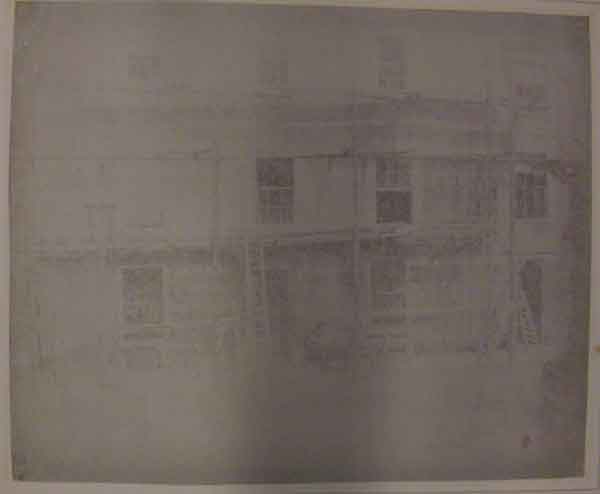1840 - 1860
Chemist and photographer
George Harper lived with his wife Frances, their four children, two servants and four young employees at Bank Plain, Norwich1. This photograph, possibly showing the Harper residence, is in the album by Thomas Damant Eaton titled ‘Camera Sketches’ in the collection of the Norfolk County Council Library and Information Service. Apart from an advertisement for photographic chemicals and a letter to Henry Talbot nothing seems to be in the public domain about Harper.
Sources and Notes
- Both the 1851 Census and Mason’s 1852 Directory list him as a ‘Chemist & Druggist.
Advertisement in the Norwich Chronicle, 2nd August 1856.
To Photographers
HARPER AND SUTTON.
CHEMISTS
Opposite Messrs. Gurneys’ Bank, Norwich,
BEG to acquaint the photographic Public that
they are now prepared to supply all the Chemi -
cals necessary for Barnes Dry Collodion process2.
The Collodion can either be had as prepared by
Knight and Co., in 4oz. bottles, 4s. 6d., or as pre -
pared carefully by themselves, at 1s. per oz., or in
4oz. stopped bottles 4s. The Bath ready prepared for
use, according to Barnes’ formula, 7s. 6d. per impe -
rial pint; also the Developing Solution, Kaolin,
Tincture of Iodine, Solution of Chloride of Gold,
Pure Wood Naphtha, and all other Chemicals for
Photographic purposes. - Barnes, Robert Freeman. The Dry Collodion Process. London: R. F. Barnes & Co., Photographers, May 1856.
In 1858 Henry Talbot patented a process he called photoglyphic engraving and, despite the patent, Harper wrote to Talbot asking for advice relating to his own [Harper’s] attempt at using this process. There is no record of any reply by Talbot.
Schaaf, Professor Larry J. [Project Director]. The Correspondence of William Henry Fox Talbot. The correspondence is held in the Fox Talbot Collection in the British Library and has been transcribed and published online.
Laboratory, Bank Plain,
Norwich
Nov 17 /58
To H. Fox Talbot Esqre
Sir,
We trust you will not think us troublesome if we ask you a question relating to the engraving process patented by you and some prints from which were published in the Photo News last week –
We have been trying some plates for amusement but can only partially succeed This day, we exposed one of Ferrier’s transparent positives upon the carefully prepared copper plate for 2½ hours the actinic power being slow, about one half hour was bright sunshine – the picture was slightly visible when taken out of the frame – it was then dusted over with fine resin smelted (not being able previously to get a nice coating of copal upon a plate we tried) and the various solutions as recommended in the specification applied – we obtained here & there black spots etched into the plate but only a very faint etching of the picture, so faint as to be scarcely perceptible Will you be good enough to inform us whether the fault was owing to insufficient exposure, or to anything wrong about the coat of resin –
We feel sure the solutions No 1. 2. 3 were right enough as they were prepared very carefully – and were successively tried for nearly an hour
We are Sir Yours most respy, Harper & Sutton
[envelope:] H. Fox Talbot Esqr . Laycock Abbey Wiltshire

George Harper
House repairing, Bank Plain, Norwich
Salted paper print, July 1845
[Norfolk County Council Library and Information Service]